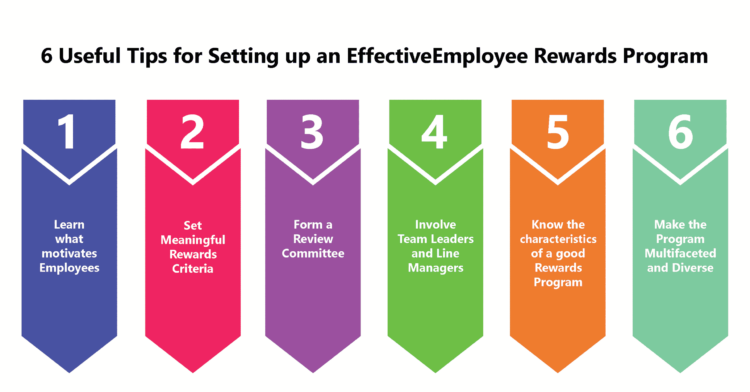1. Understand employee motivations: Use surveys and data analysis to identify common factors that motivate employees, establishing a strong foundation for the rewards program.
2. Set meaningful and fair criteria: Ensure rewards have clear, unbiased criteria that apply to all employees, regardless of their role or relationships with managers.
3. Form a review committee and involve team leaders: Create a committee of unbiased managers to oversee the program, and include input from team leaders and line managers to accurately assess performance and contributions.
4. Design a diverse and multifaceted program: Create a rewards program that is timely, specific, and valuable, incorporating various types of recognition to keep it engaging while avoiding insensitivity to employees’ diverse needs.
Most business organizations today know the importance of rewarding employees to enhance their satisfaction and loyalty. Here are a few valuable tips for setting up an effective employee rewards program:
Although all organizations today are aware of the importance of rewarding their employees, when it comes to actually building an effective employee rewards program, most organizations are unaware of where to begin.
Discussed below are some valuable tips for setting up an effective employee rewards program:
1. Learn What Motivates Employees
2. Set Meaningful Rewards Criteria
3. Form a Review Committee
4. Involve Team Leaders and Line Managers
5. Know the Characteristics of a Good Rewards Program
6. Make the Program Multifaceted and Diverse


Employee temperaments and personalities can differ significantly. It means that what they value and derive motivation from can be distinct from each other.
Despite these differences, employees from the same business unit or team share common motivation factors.
Learning about these general motivation factors can help in establishing a strong base for designing an effective employee rewards program.
The organization could analyze the data collected through an employee survey to understand the most common motivation factors.

Importantly, a successful rewards program is based on meaningful criteria to avoid biases or random actions.
Employees would only be considered for the reward if they fulfilled clearly defined criteria.
Organizations need to ensure that employees with good relationships with their managers or team leaders are not favored for the rewards.
Most importantly, each employee should be able to receive recognition, irrespective of their level and role within the organization.

Regardless of an organization’s size, forming a committee to oversee the employee recognition program is highly advisable.
To begin with, the committee may consist of just a few senior and mid-level managers.
The members of the committee must be known for their honest and unbiased decision-making capabilities.
Organizations must also promote that serving on the committee is a matter of privilege and pride.

The feedback from their team leaders matters the most when assessing employees’ overall performance, contributions, and achievements.
Hence the organization needs to ensure the involvement of the team leaders in any rewards program to make it truly effective and successful.
However, most organizations seek input only from HR and ignore the opinions of team leaders and line managers.
However, when combined with the strategic viewpoints of HR and line management, it can add much value to the program.

Here are a few critical points of a good recognition program:
1. It should be timely, as any delay in rewarding and recognizing diminishes its value.
2. It should follow a regular schedule integrated with the business operations.
3. It should be specific, meaning it should aim to acknowledge a particular employee’s achievement or contribution.
4. It should have some tangible value so the employee feels motivated even after receiving the reward.
6. It should be value-based to motivate employees to work towards common objectives.

Additionally, creating variety in the rewards and recognition program keeps the concept fresh and exciting.
However, it is essential to ensure that the variety should not compromise the sensitivities of specific workforce members.
It can render the entire program ineffective and even demotivate employees.
An effective employee rewards program can help organizations in engaging and motivating the employees, which in turn can give them a competitive edge.
Developing such programs is not as difficult as it may seem, especially if organizations follow the above-discussed tips to enhance the program’s business impact.

Lead author: Sagar Chaudhuri, the Co-Founder and CEO of HiFives. He is an HR Tech Evangelist with over 25 years of experience in both corporate and entrepreneurial settings. Previously, Sagar has held leadership roles with companies such as Genpact, Infosys, and ICICI Bank. He has an engineering degree from IIT Kharagpur and an MBA from IIM Lucknow. Connect on LinkedIn
To stay updated on the latest HiFives blogs, follow us on Twitter (@MyHiFives)